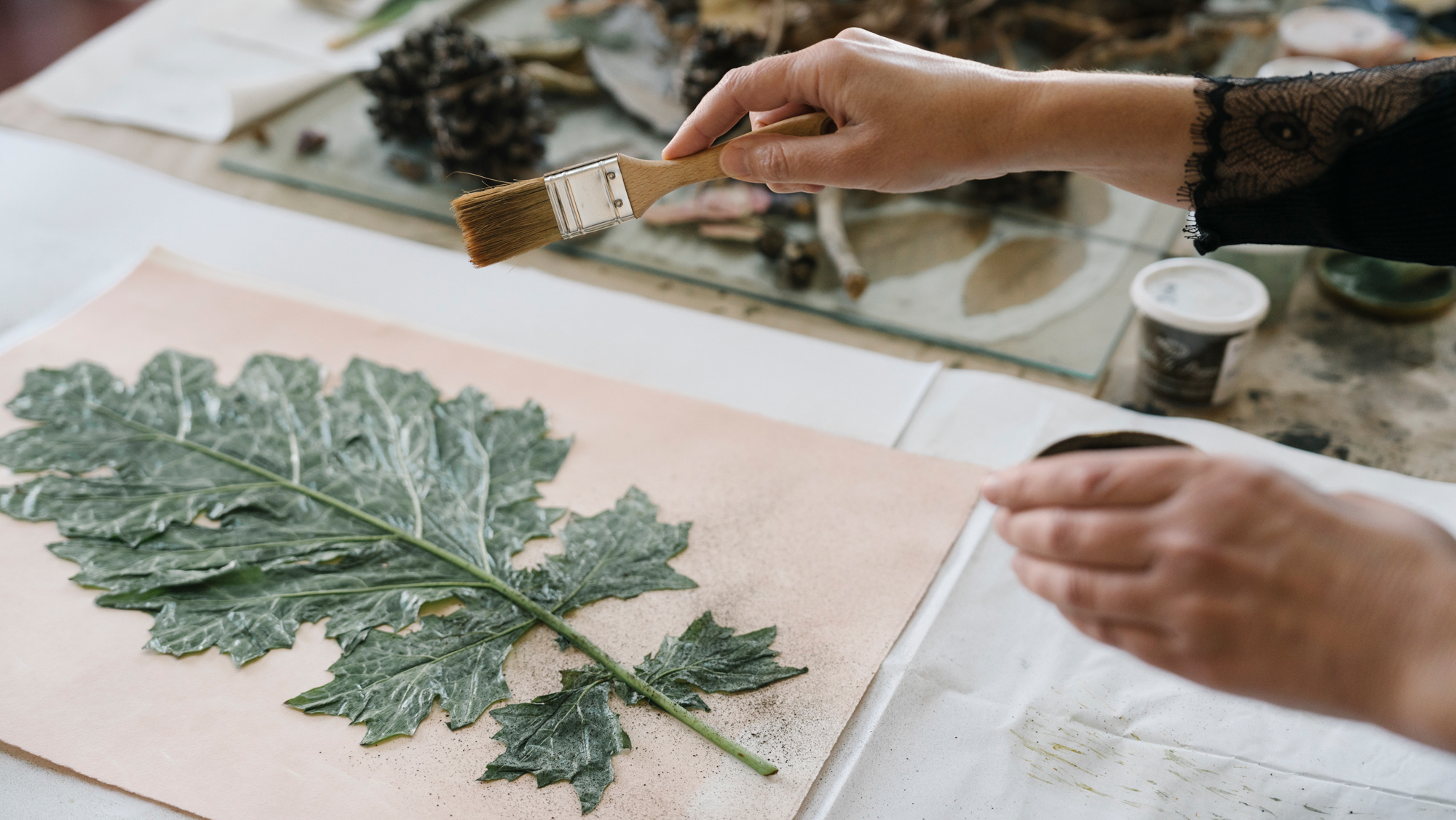Miranda Mote – Botanical Autopsies: Plants and People

Miranda Mote working in her studio at the Academy (photograph by Claudia Gori)
Botanical Autopsies is a public exhibition of botanical prints by Miranda Mote (2024 Fellow), made with the plants of the Non-Catholic Cemetery for Foreigners in Rome. The prints will be displayed in the cemetery’s Autopsy Room from April 4 to May 2, 2024, with a public opening on April 11.
Opening Reception
Thursday, April 11, 2024
4:00–6:00pm CET
Exhibition Days and Times
April 4–May 2, 2024, during the opening hours of the cemetery. Please visit the cemetery website for more information.
Artist’s Statement
Standing on top of Monte Testaccio looking east, I saw a dense canopy of Pinus pinea (Italian Stone Pines) and Cypress trees neatly nestled up against the Aurelian Roman wall and the Pyramid. The pyramid was built in 12 BCE as a tomb honoring Caius Cestius. The wall was built in the third century AD to enclose Rome’s expanding urban core. The first non-Catholic burial near the pyramid was recorded to be in 1716. Although inside the wall, this area of Rome in the early 18th century was a meadow with trees that was used for grazing animals. The cemetery is extraordinary because its canopy of trees shelter a human history of Rome as an international city, but also because it is a micro-environment, an urban ecology that has been cultivated since the early 1700’s.
The tree canopy shelters the memories and mortality of over six thousand people and centuries of botanical lives—that is Pines, Cypress, Violets, Acanthus, Bergenias, and many others. There are hundreds of species of herbaceous and woody plants growing in the cemetery, some were planted while others grow spontaneously. Because of its gracious tree canopy and enclosing walls, the cemetery is functioning as an anomalous urban ecology in Rome: birds, insects, plants, animals, and humans. The trees and the understory ecology is a bio-cultural asset to the city; the Cemetery gives Romans and visitors a sense of well-being because it assures ecological and cultural resilience to the hostility of climate change and time. It is a heritage garden landscape.
Botanical Autopsies is an exhibition of botanical prints that contemplates aspects of the cemetery’s botanical and cultural history: eight plant species, the names of 1,895 people recorded in its burial records between 1716 and December 13, 1894, and the life of an African American woman buried in the cemetery. The botanical prints are displayed on a table in the center of the Cemetery’s former autopsy room, under a skylight so that the plants can be studied in the same place where bodies were carefully examined and prepared for burial. Preserved plant specimens are hung on the north and south walls of the room to call attention to the nuances of their sculptural bodies. Small devotional cards have been printed to honor the life and burial of Sarah Parker Remond, who was born in Salem, Massachusetts, in 1826. Remond traveled throughout England campaigning and lecturing for the abolition of slavery, studied and practiced medicine in Florence, and died in Rome on December 13, 1894. Although she was buried in the new part of the cemetery, her remains were placed in the ossuary next to the Roman wall before 1940. I have equated her life with that of the violets that grow throughout the cemetery; her voice was resilient and beautiful, like a violet. On his deathbed in 1821, John Keats—also buried in the cemetery—claimed these violets as already growing from his body. But there are multitudes of violets here. Sarah, this is your home, a bed of violets is growing from your soil.
The project is made possible by the Fellows’ Project Fund of the American Academy in Rome.
Special thanks to the staff of the American Academy in Rome and the director, Yvonne A. Mazurek, staff and volunteers of the Non-Catholic Cemetery for Foreigners in Rome.
About the Artist
Miranda Mote is the 2024 Garden Club of America/Prince Charitable Trusts Rome Prize Fellow in landscape architecture. She is a historian, artist, and educator based in Philadelphia. Mote graduated with a BArch from University of Cincinnati (1995), an MDes in history and philosophy of design from the Harvard Graduate School of Design (2015), where her thesis was awarded distinction by the faculty, and a PhD in the history and theory of architecture at the University of Pennsylvania (2021). She has taught for Temple University and Pratt Institute and is currently at the University of Pennsylvania.
As an artist, Mote has developed nature printing techniques based on her historical research into the poetics of botanical image making. Her work with the Penn Program in Environmental Humanities in 2021 supported her interest in addressing environmental injustice in Philadelphia and the establishment of Botanography, a nonprofit organization that directly serves students in schools of Philadelphia with arts-focused literacy and botany programming. While in residence at AAR, Mote has been working with children at two schools in Monteverde and the Academy teaching botanical arts and has been developing her own botanical printmaking methods.
The Non-Catholic Cemetery in Rome. The Cemetery for non-Catholics in Rome dates back to at least 1716 when records show that members of the Stuart Court in exile from England were allowed by Pope Clement XI to be buried in front of the Pyramid. Other non-Catholics, many of them young people on the Grand Tour, were successively allowed to be buried here. By 1738 and 1821 over one hundred people were buried in the old part of the cemetery. In 1822 land was granted for the expansion of the cemetery into what is now called the New Cemetery. In 1894, the Cemetery expanded to its current size and was later enclosed by the perimetral wall we see today. As of 2024, just over 6,000 people have been buried in the Cemetery.
April 4–May 2, 2024
The project is made possible by the Fellows’ Project Fund of the American Academy in Rome.